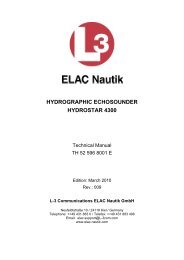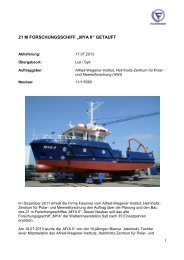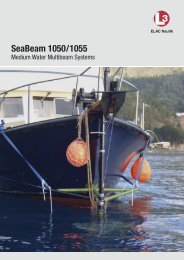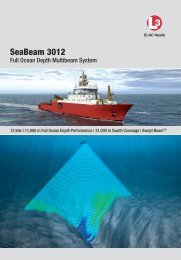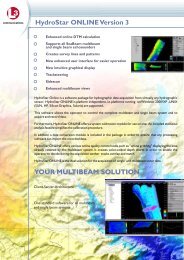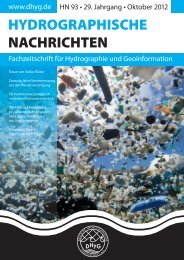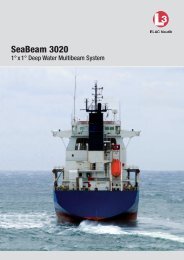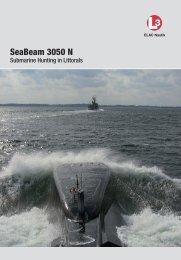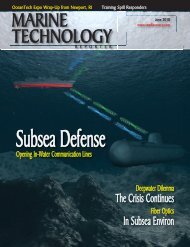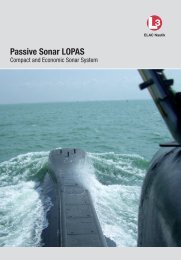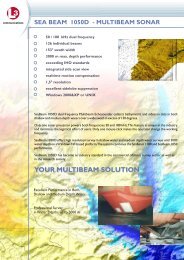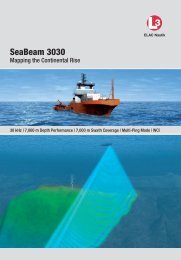SeaBeam 3050 - Elac-Nautik
SeaBeam 3050 - Elac-Nautik
SeaBeam 3050 - Elac-Nautik
You also want an ePaper? Increase the reach of your titles
YUMPU automatically turns print PDFs into web optimized ePapers that Google loves.
<strong>SeaBeam</strong> <strong>3050</strong><br />
Mapping the Continental Slope<br />
Image: FASSMER<br />
50 kHz | 3,000 m Depth Performance | 3,500 m Swath Coverage | Multi-Ping Mode | WCI
DISCOVER THE UNKNOWN<br />
<strong>SeaBeam</strong> <strong>3050</strong><br />
Medium Depth Multibeam System<br />
The <strong>SeaBeam</strong> <strong>3050</strong> multibeam echo sounder collects bathymetric, corrected backscatter, sidescan and<br />
Water Column Imaging (WCI) data in medium depth over a wide swath in excess of 140 degrees, meeting all<br />
relevant survey standards. Due to its depth performance in combination with wide coverage, <strong>SeaBeam</strong> <strong>3050</strong><br />
is the ideal hydrographic sensor for mapping the continental slope.<br />
Multi-Ping Technique<br />
A big advantage of the <strong>SeaBeam</strong> <strong>3050</strong> is the new multiping<br />
technique. The system compensates fully for vessel<br />
roll, pitch and yaw motion and transmits and processes<br />
two swaths in one ping. Bathymetric depth information,<br />
amplitude (backscatter) data, WCI data and side scan<br />
imagery are acquired by the system in real-time.<br />
The new multi-ping technique allows a higher maximum<br />
survey speed without losing 100% bottom coverage by<br />
creating two swaths per ping cycle, which is important<br />
especially for narrow along-ship beam widths.<br />
For 1° along-ship resolution and 140° swath width<br />
<strong>SeaBeam</strong> <strong>3050</strong> allows for a survey speed of more than<br />
14 knots. On the other hand, at the same survey speed<br />
a bottom segment is ensonifi ed two times more often<br />
than using a single-ping mode.<br />
post-processing with modern processing methodologies like CUBE and enhances<br />
the quality of the fi nal products.<br />
Performance<br />
The system operates in the 50 kHz frequency band in water depths ranging from<br />
3 m below the transducers to approx. 3,000 m. <strong>SeaBeam</strong> <strong>3050</strong> can be utilized at<br />
survey speeds of up to 14 knots. It has an across-ship swath width of up to 140<br />
degrees. A maximum of 630 beams is provided for each multiping. The depth<br />
accuracy of the sonar sensor exceeds the IHO requirements.<br />
Transmission Technique<br />
<strong>SeaBeam</strong> <strong>3050</strong> uses a transmission technique, which compensates fully for vessel<br />
pitch and yaw motion. This is achieved by splitting the transmit fan in several<br />
sectors which can be steered individually. This technique achieves full motion<br />
compensation and guarantees a stable straight coverage under the vessel.<br />
The result is a higher data density at the same survey<br />
speed. This increases the target detection and classifi -<br />
cation abilities. A high data density is advantageous for<br />
Key Features<br />
Up to 3,000 m Depth Performance<br />
Up to 3,500 m Bottom Coverage<br />
Multi-Ping Mode<br />
Real-time Water Column Imaging (WCI)<br />
Mobile Version for up to 1.5° x 2° Beam Width<br />
optional:<br />
Transducers adapted to Specific Ship's Hull<br />
<strong>SeaBeam</strong> <strong>3050</strong> multibeam system<br />
2
<strong>SeaBeam</strong> <strong>3050</strong><br />
System Overview<br />
Compact Design for Easy Integration<br />
Transducer Array<br />
The projector array and the hydrophone array are arranged in a mills-cross confi<br />
guration. Preamplifi ers are built in the hydrophone array. The projector array as<br />
well as the hydrophone array is split in multiple modules (projector module LSE<br />
330 and hydrophone module KE 15).<br />
Operator Station<br />
The operation station (and also the optional WCI workstation)<br />
is typically a high-end marine COTS PC or<br />
laptop, which is currently available on the market and<br />
which is running under Microsoft Windows. The operator<br />
station provides the human machine interface (HMI) to<br />
the operator. It shows the various depths, backscatter<br />
amplitudes, side scan data, position and other relevant<br />
information. Furthermore, it offers the operator the possibility<br />
to make appropriate settings for <strong>SeaBeam</strong> <strong>3050</strong>.<br />
The standard sonar HMI application for control and data<br />
acquisition is HydroStar ONLINE. The system also supports<br />
third party data acquisition software solutions like<br />
HYPACK, EIVA, QINSy and Triton.<br />
Fix and mobile installation<br />
This allows the customization of the required along-ship and across-ship beam<br />
widths. The standard installation of the transducer array is fl ush with the ship<br />
hull. A blister or a gondola installation is also possible. For mobile applications of<br />
up to 1.5° x 2° resolution a transducer bracket for pole installation is available.<br />
Transceiver Unit SEE 37<br />
The transceiver unit contains the transmitter and receiver electronics. It consists<br />
of the transmitter amplifi ers, the transmit beam former and the sonar controller<br />
board, which provides the interfaces to the other units and mainly handles all<br />
control tasks within the transceiver unit.<br />
Furthermore, the transceiver unit contains the necessary elements for signal conditioning<br />
and sonar processing. This includes the Digital Down Conversion (DDC)<br />
and the receive beam former as well as information processing like the bottom<br />
depth fi nder, sound velocity correction and alignment correction.<br />
In order to minimize the big data volumes, which are acquired during high-resolution<br />
Water Column Imaging (WCI) without information loss related to the wanted<br />
signal, specifi c algorithms and software components are implemented.<br />
Water Column Imaging (WCI) Workstation<br />
<strong>SeaBeam</strong> <strong>3050</strong> is WCI ready, no extra installation is needed.<br />
The HydroStar WCI Viewer is a tool for online and<br />
offl ine visualization of high-resolution WCI or stave-oriented<br />
raw data. The data formats are open to the public.<br />
The HydroStar WCI Viewer software package is adapted<br />
to scientifi c and operational requirements concerning<br />
Water Column Imaging.<br />
Gas Bubble Detection<br />
Submarine gas hydrates are of major importance concerning<br />
climate change and energy supply. An important<br />
basis for gas hydrate exploration is the ability to<br />
detect gas bubbles in the water column online and offline.<br />
This ability requires the storage and visualization of<br />
high-resolution Water Column Image (WCI) data during<br />
surveying.<br />
This technical challenge has been addressed by the<br />
German lighthouse research project SUGAR (Submarine<br />
Gas Hydrate Reservoirs), in which L-3 ELAC <strong>Nautik</strong> participates<br />
as an important industrial partner.<br />
3
SB <strong>3050</strong> l SB 3030 l SB 3020 l SB 3012<br />
Specifications and Technical Data<br />
<strong>SeaBeam</strong> <strong>3050</strong> at a Glance<br />
Technical Data<br />
Operating frequency<br />
50 kHz band<br />
Along track beam width 1° / 1.5° or 3°<br />
Across track beam width 1° or 2°<br />
Pulse length<br />
0.15 ms - 10 ms (0.15 ms only<br />
available in single-ping mode)<br />
Pulse length modes<br />
Manual and automatic<br />
Operation modes<br />
max. ping rate<br />
Single-ping and multi-ping mode<br />
50 swaths per second<br />
max. number of soundings 630 (2 x 315)<br />
Beam spacing<br />
Range resolution<br />
Depth accuracy (sonar sensor)<br />
max. swath coverage sector 140°<br />
max. coverage (approx.)<br />
min. depth (below transducer)<br />
max. depth (approx.)<br />
max. range sampling rate<br />
Physical Specifications *<br />
Hydrophone array*<br />
1° / 2°<br />
Projector array*<br />
1° / 1.5° / 3°<br />
Transmit and receive unit<br />
(permanent installation)*<br />
Equidistance or equiangular<br />
Down to 2 cm<br />
In accordance with IHO SP44<br />
special order<br />
3,500 m<br />
3 m<br />
3,000 m<br />
20 kHz<br />
(= 10 kHz inphase, quadrature phase)<br />
Interfaces<br />
Power<br />
Motion<br />
Heading<br />
Position<br />
Surface sound velocity<br />
Sound velocity profile<br />
115 V / 60 Hz or 230 V / 50 Hz<br />
single phase<br />
RS232 / RS422 or Ethernet<br />
RS232 / RS422 or Ethernet<br />
RS232 / RS422 or Ethernet<br />
RS232 / RS422<br />
RS232 / RS422 or Ethernet<br />
Height (mm) Width (mm) Depth (mm) Weight (kg)<br />
125 / 125 380 / 380 1,581 / 792<br />
Without frames and cables<br />
50 / 25<br />
150 / 150 / 150 2,284 / 1,691 / 1,098 450 / 450 / 450<br />
Without frames and cables<br />
66 / 44 / 22<br />
1,052 607 877 160<br />
Operator station* 177 (4 HE) 483 (19” rack) 505 14<br />
Mobile transducer bracket<br />
(including transducers)<br />
Stabilization<br />
Roll ± 10°<br />
Pitch ± 10°<br />
Yaw ± 5°<br />
Reliability 1° x 1°<br />
System MTBF<br />
System MTBCF<br />
Overall MTTR<br />
3,487 h<br />
3,849 h<br />
0.92 h<br />
286 1,928 789 < 312 (without cables)<br />
L-3 Communications ELAC <strong>Nautik</strong> GmbH | Neufeldtstrasse 10 | 24118 Kiel | Germany | Tel. +49 (0)431-883 0 | Fax +49 (0)431-883 496<br />
elac.marketing@L-3com.com | www.elac-nautik.de | Design changes and errors reserved. Rev. B 15/03/2013<br />
*Dimensions may change due to special installation requirements. Please ask for dimensional drawings.<br />
4



